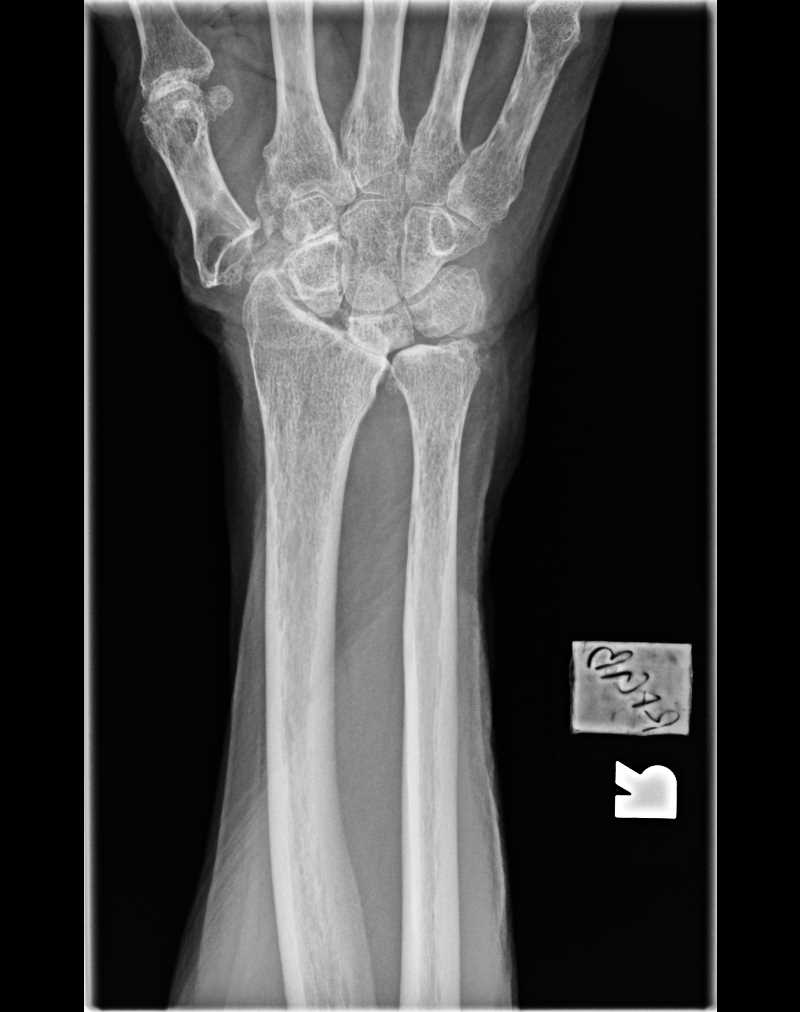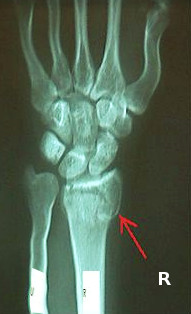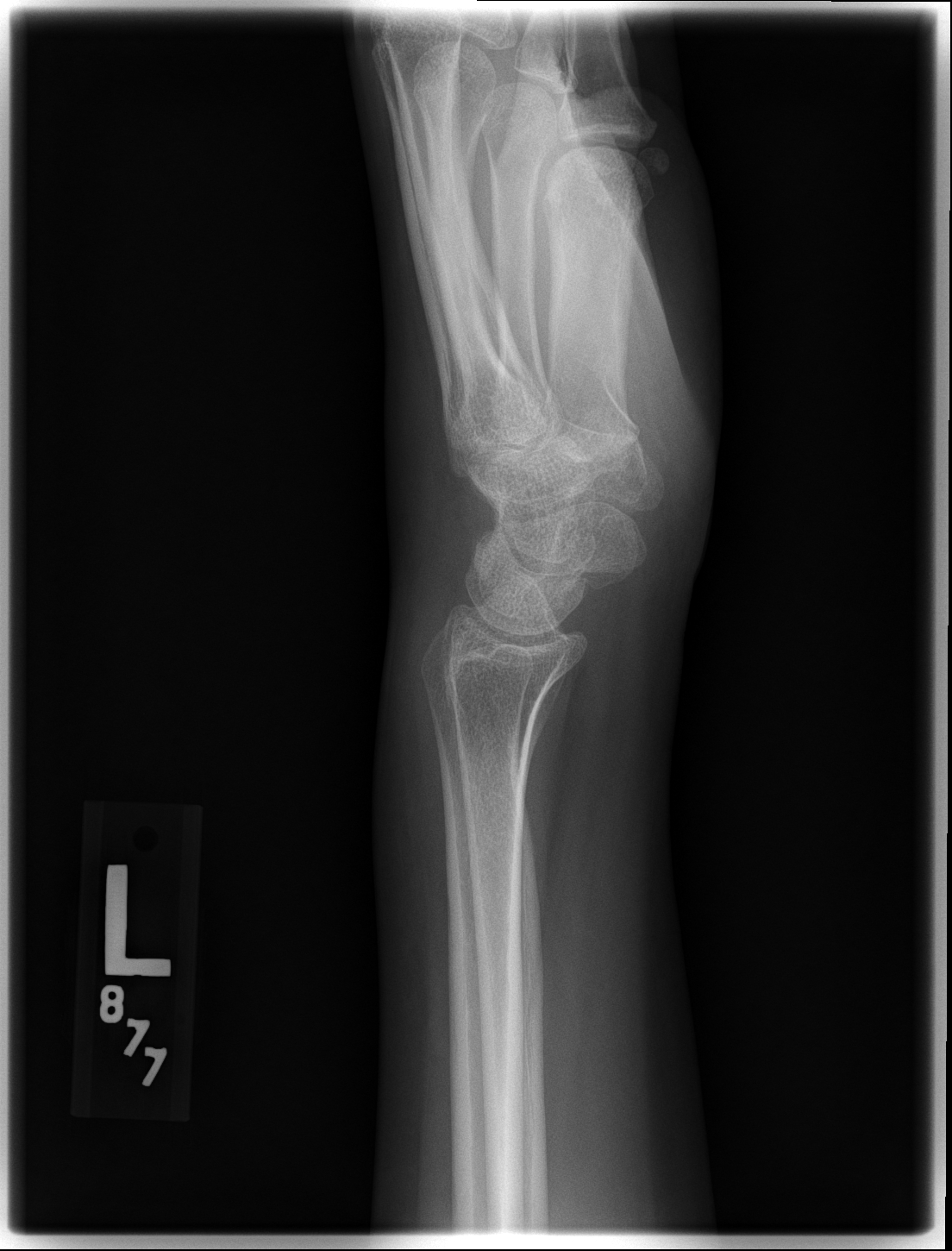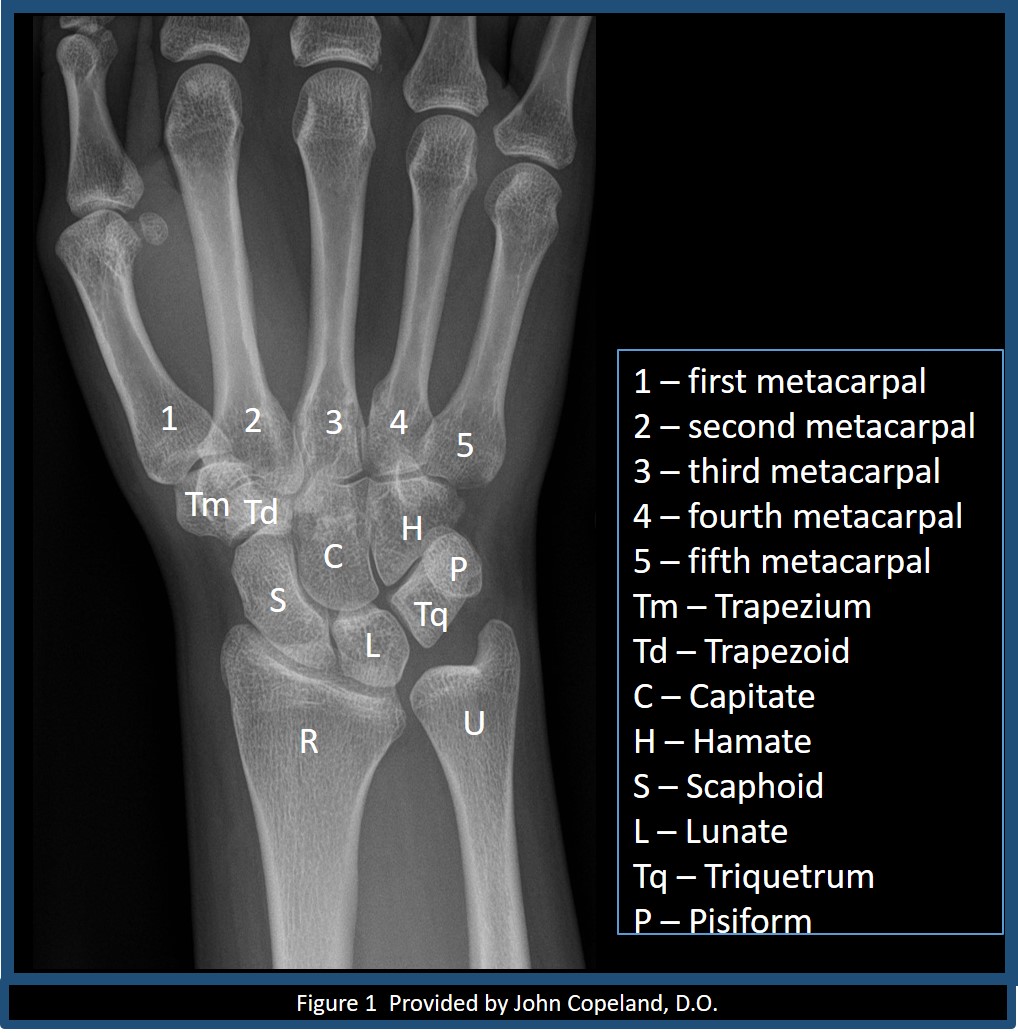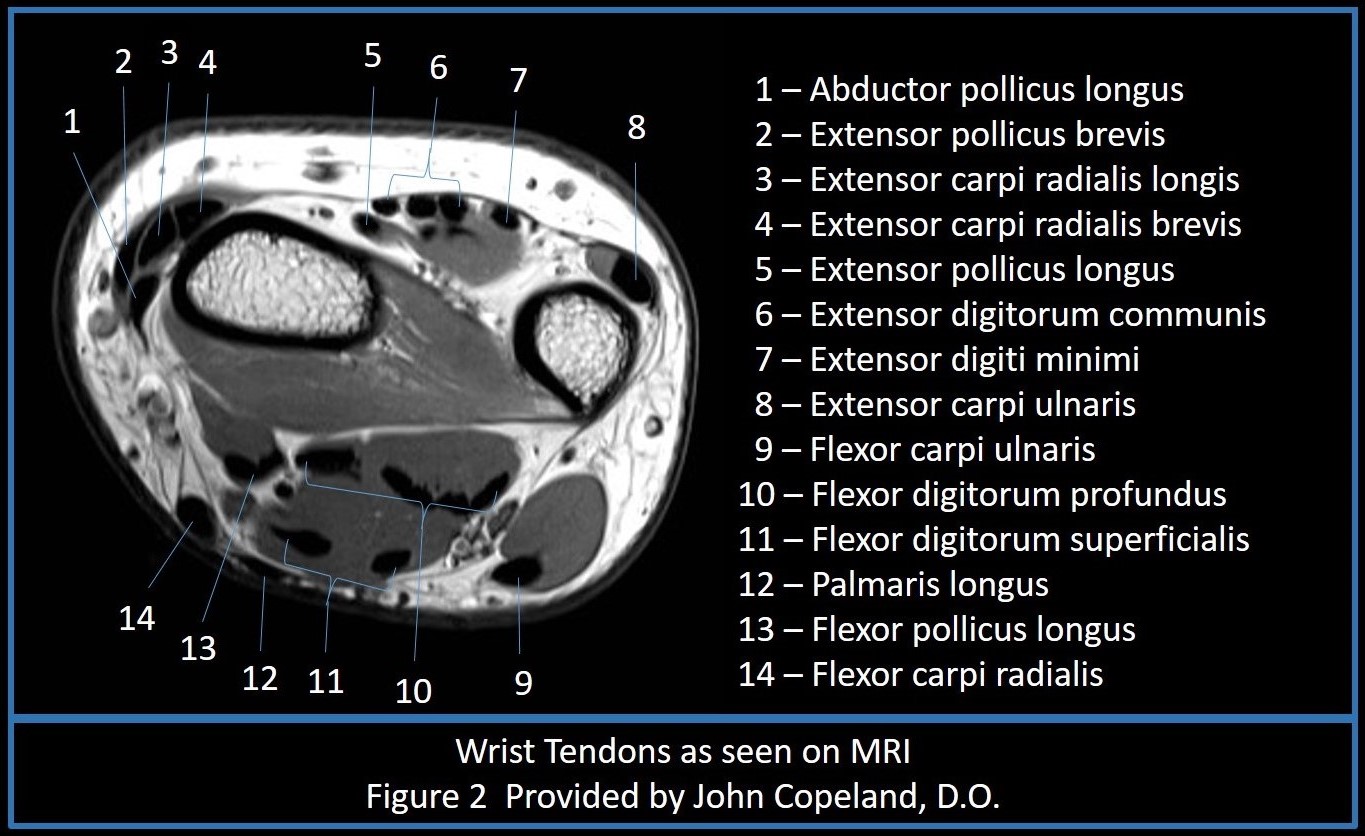[1]
Kijima Y, Viegas SF. Wrist anatomy and biomechanics. The Journal of hand surgery. 2009 Oct:34(8):1555-63. doi: 10.1016/j.jhsa.2009.07.019. Epub
[PubMed PMID: 19801111]
[3]
Pourahmadi MR, Ebrahimi Takamjani I, Sarrafzadeh J, Bahramian M, Mohseni-Bandpei MA, Rajabzadeh F, Taghipour M. Reliability and concurrent validity of a new iPhone(®) goniometric application for measuring active wrist range of motion: a cross-sectional study in asymptomatic subjects. Journal of anatomy. 2017 Mar:230(3):484-495. doi: 10.1111/joa.12568. Epub 2016 Dec 2
[PubMed PMID: 27910103]
Level 2 (mid-level) evidence
[4]
Gustus A, van der Smagt P. Evaluation of joint type modelling in the human hand. Journal of biomechanics. 2016 Sep 6:49(13):3097-3100. doi: 10.1016/j.jbiomech.2016.07.018. Epub 2016 Jul 27
[PubMed PMID: 27494988]
[5]
Babic RR, Stankovic Babic G, Babic SR, Babic NR. 120 YEARS SINCE THE DISCOVERY OF X-RAYS. Medicinski pregled. 2016 Sep:69(9-10):323-330
[PubMed PMID: 29693857]
[6]
Almond PR. The x-ray centennial--Thompsons and Thomsons. Medical physics. 1993 Mar-Apr:20(2 Pt 1):275-81
[PubMed PMID: 8497211]
[7]
Aparisi Gómez MP, Aparisi F, Battista G, Guglielmi G, Faldini C, Bazzocchi A. Functional and Surgical Anatomy of the Upper Limb: What the Radiologist Needs to Know. Radiologic clinics of North America. 2019 Sep:57(5):857-881. doi: 10.1016/j.rcl.2019.03.002. Epub 2019 May 8
[PubMed PMID: 31351538]
[8]
Jawed A, Ansari MT, Gupta V. TFCC injuries: How we treat? Journal of clinical orthopaedics and trauma. 2020 Jul-Aug:11(4):570-579. doi: 10.1016/j.jcot.2020.06.001. Epub 2020 Jun 9
[PubMed PMID: 32742122]
[9]
Sophia Fox AJ, Bedi A, Rodeo SA. The basic science of articular cartilage: structure, composition, and function. Sports health. 2009 Nov:1(6):461-8
[PubMed PMID: 23015907]
[10]
Berger RA. The anatomy of the ligaments of the wrist and distal radioulnar joints. Clinical orthopaedics and related research. 2001 Feb:(383):32-40
[PubMed PMID: 11210966]
[11]
Palmer AK, Werner FW. The triangular fibrocartilage complex of the wrist--anatomy and function. The Journal of hand surgery. 1981 Mar:6(2):153-62
[PubMed PMID: 7229292]
[12]
Wu WT, Chang KV, Mezian K, Naňka O, Yang YC, Hsu YC, Hsu PC, Özçakar L. Ulnar Wrist Pain Revisited: Ultrasound Diagnosis and Guided Injection for Triangular Fibrocartilage Complex Injuries. Journal of clinical medicine. 2019 Sep 25:8(10):. doi: 10.3390/jcm8101540. Epub 2019 Sep 25
[PubMed PMID: 31557886]
[13]
Ng AWH, Griffith JF, Fung CSY, Lee RKL, Tong CSL, Wong CWY, Tse WL, Ho PC. MR imaging of the traumatic triangular fibrocartilaginous complex tear. Quantitative imaging in medicine and surgery. 2017 Aug:7(4):443-460. doi: 10.21037/qims.2017.07.01. Epub
[PubMed PMID: 28932701]
[14]
Nigro RO. Anatomy of the flexor retinaculum of the wrist and the flexor carpi radialis tunnel. Hand clinics. 2001 Feb:17(1):61-4, vi
[PubMed PMID: 11280159]
[15]
Presazzi A, Bortolotto C, Zacchino M, Madonia L, Draghi F. Carpal tunnel: Normal anatomy, anatomical variants and ultrasound technique. Journal of ultrasound. 2011 Mar:14(1):40-6. doi: 10.1016/j.jus.2011.01.006. Epub 2011 Feb 3
[PubMed PMID: 23396809]
[17]
Saito T, Sterbenz JM, Chung KC. Chronologic and Geographic Trends of Triangular Fibrocartilage Complex Repair. Hand clinics. 2017 Nov:33(4):593-605. doi: 10.1016/j.hcl.2017.07.010. Epub
[PubMed PMID: 28991572]
[18]
Phillips TG, Reibach AM, Slomiany WP. Diagnosis and management of scaphoid fractures. American family physician. 2004 Sep 1:70(5):879-84
[PubMed PMID: 15368727]
[19]
Wong WC, Ho PC. Arthroscopic Management of Scaphoid Nonunion. Hand clinics. 2019 Aug:35(3):295-313. doi: 10.1016/j.hcl.2019.03.003. Epub 2019 May 12
[PubMed PMID: 31178088]
[20]
Floranda EE, Jacobs BC. Evaluation and treatment of upper extremity nerve entrapment syndromes. Primary care. 2013 Dec:40(4):925-43, ix. doi: 10.1016/j.pop.2013.08.009. Epub 2013 Sep 29
[PubMed PMID: 24209726]
[21]
Soubeyrand M, Melhem R, Protais M, Artuso M, Crézé M. Anatomy of the median nerve and its clinical applications. Hand surgery & rehabilitation. 2020 Feb:39(1):2-18. doi: 10.1016/j.hansur.2019.10.197. Epub 2019 Dec 6
[PubMed PMID: 31816428]
[23]
Polatsch DB, Melone CP Jr, Beldner S, Incorvaia A. Ulnar nerve anatomy. Hand clinics. 2007 Aug:23(3):283-9, v
[PubMed PMID: 17765580]
[24]
Bansal GJ. Digital radiography. A comparison with modern conventional imaging. Postgraduate medical journal. 2006 Jul:82(969):425-8
[PubMed PMID: 16822918]
[25]
Michelotti BF, Mathews A, Chung KC. Appropriateness of the Use of Magnetic Resonance Imaging in the Diagnosis and Treatment of Wrist Soft Tissue Injury. Plastic and reconstructive surgery. 2018 Feb:141(2):410-419. doi: 10.1097/PRS.0000000000004023. Epub
[PubMed PMID: 29036028]
[26]
Bernier D, Marteau E, Roulet S, Antar H, Triki A, Laulan J, Bacle G. Hydroxyapatite deposits of the hand and wrist: a diagnosis not to be ignored. The Pan African medical journal. 2021:38():408. doi: 10.11604/pamj.2021.38.408.29253. Epub 2021 Apr 29
[PubMed PMID: 34381552]
[27]
Chodick G, Kim KP, Shwarz M, Horev G, Shalev V, Ron E. Radiation risks from pediatric computed tomography scanning. Pediatric endocrinology reviews : PER. 2009 Dec:7(2):29-36
[PubMed PMID: 20118891]
[28]
Lee SK, Desai H, Silver B, Dhaliwal G, Paksima N. Comparison of radiographic stress views for scapholunate dynamic instability in a cadaver model. The Journal of hand surgery. 2011 Jul:36(7):1149-57. doi: 10.1016/j.jhsa.2011.05.009. Epub 2011 Jun 14
[PubMed PMID: 21676555]
[29]
Theumann NH, Etechami G, Duvoisin B, Wintermark M, Schnyder P, Favarger N, Gilula LA. Association between extrinsic and intrinsic carpal ligament injuries at MR arthrography and carpal instability at radiography: initial observations. Radiology. 2006 Mar:238(3):950-7
[PubMed PMID: 16424247]
[30]
Wilczek ML, Kälvesten J, Algulin J, Beiki O, Brismar TB. Digital X-ray radiogrammetry of hand or wrist radiographs can predict hip fracture risk--a study in 5,420 women and 2,837 men. European radiology. 2013 May:23(5):1383-91. doi: 10.1007/s00330-012-2706-9. Epub 2012 Nov 16
[PubMed PMID: 23229168]
[31]
Grunz JP, Gietzen CH, Christopoulos G, van Schoonhoven J, Goehtz F, Schmitt R, Hesse N. Osteoarthritis of the Wrist: Pathology, Radiology, and Treatment. Seminars in musculoskeletal radiology. 2021 Apr:25(2):294-303. doi: 10.1055/s-0041-1730948. Epub 2021 Aug 9
[PubMed PMID: 34374064]
[32]
Mallee WH, Wang J, Poolman RW, Kloen P, Maas M, de Vet HC, Doornberg JN. Computed tomography versus magnetic resonance imaging versus bone scintigraphy for clinically suspected scaphoid fractures in patients with negative plain radiographs. The Cochrane database of systematic reviews. 2015 Jun 5:2015(6):CD010023. doi: 10.1002/14651858.CD010023.pub2. Epub 2015 Jun 5
[PubMed PMID: 26045406]
Level 1 (high-level) evidence
[33]
Britz GW, Haynor DR, Kuntz C, Goodkin R, Gitter A, Kliot M. Carpal tunnel syndrome: correlation of magnetic resonance imaging, clinical, electrodiagnostic, and intraoperative findings. Neurosurgery. 1995 Dec:37(6):1097-103
[PubMed PMID: 8584150]
[34]
Spina V, Barbuti D, Gaeta A, Palmucci S, Soscia E, Grimaldi M, Leone A, Manara R, Polonara G. The role of imaging in the skeletal involvement of mucopolysaccharidoses. Italian journal of pediatrics. 2018 Nov 16:44(Suppl 2):118. doi: 10.1186/s13052-018-0556-z. Epub 2018 Nov 16
[PubMed PMID: 30442151]
[35]
Gilley E, Puri SK, Hearns KA, Weiland AJ, Carlson MG. Importance of Computed Tomography in Determining Displacement in Scaphoid Fractures. Journal of wrist surgery. 2018 Feb:7(1):38-42. doi: 10.1055/s-0037-1604136. Epub 2017 Jul 6
[PubMed PMID: 29383274]
[36]
Pooley RA. AAPM/RSNA physics tutorial for residents: fundamental physics of MR imaging. Radiographics : a review publication of the Radiological Society of North America, Inc. 2005 Jul-Aug:25(4):1087-99
[PubMed PMID: 16009826]
[37]
Kloen P, Buijze GA, Ring D. Management of forearm nonunions: current concepts. Strategies in trauma and limb reconstruction. 2012 Apr:7(1):1-11. doi: 10.1007/s11751-011-0125-0. Epub 2011 Nov 24
[PubMed PMID: 22113538]
[38]
Merhar GL, Clark RA, Schneider HJ, Stern PJ. High-resolution computed tomography of the wrist in patients with carpal tunnel syndrome. Skeletal radiology. 1986:15(7):549-52
[PubMed PMID: 3775421]
[39]
Bille B, Harley B, Cohen H. A comparison of CT arthrography of the wrist to findings during wrist arthroscopy. The Journal of hand surgery. 2007 Jul-Aug:32(6):834-41
[PubMed PMID: 17606063]
[40]
Jacobs MA, Ibrahim TS, Ouwerkerk R. AAPM/RSNA physics tutorials for residents: MR imaging: brief overview and emerging applications. Radiographics : a review publication of the Radiological Society of North America, Inc. 2007 Jul-Aug:27(4):1213-29
[PubMed PMID: 17620478]
Level 3 (low-level) evidence
[42]
Ohana O, Soffer S, Zimlichman E, Klang E. Overuse of CT and MRI in paediatric emergency departments. The British journal of radiology. 2018 May:91(1085):20170434. doi: 10.1259/bjr.20170434. Epub 2018 Feb 5
[PubMed PMID: 29271231]
[43]
Young DW. What does an MRI scan cost? Healthcare financial management : journal of the Healthcare Financial Management Association. 2015 Nov:69(11):46-9
[PubMed PMID: 26685437]
[44]
Dioguardi P, Gaddam SR, Zhuang H, Torigian DA, Alavi A. FDG PET Assessment of Osteomyelitis: A Review. PET clinics. 2012 Apr:7(2):161-79. doi: 10.1016/j.cpet.2012.01.011. Epub
[PubMed PMID: 27157234]
[45]
Parent ME, Vézina F, Carrier N, Masetto A. Indications for and clinical procedures resulting from magnetic resonance imaging of the knee in older patients: Are we choosing wisely? Canadian family physician Medecin de famille canadien. 2018 Mar:64(3):e126-e132
[PubMed PMID: 29540401]
[46]
Xiao F, Griffith JF, Ko JKL, Yue J, Leung JCS, Yeung DKW, Tam LS. MRI wrist in early rheumatoid arthritis: reduction in inflammation assessed quantitatively during treatment period correlates best with clinical improvement. Skeletal radiology. 2021 Jul:50(7):1337-1345. doi: 10.1007/s00256-020-03669-5. Epub 2020 Nov 26
[PubMed PMID: 33244616]
[47]
Hsu CY, Lu HC, Shih TT. Tuberculous infection of the wrist: MRI features. AJR. American journal of roentgenology. 2004 Sep:183(3):623-8
[PubMed PMID: 15333346]
[48]
Bianchi S, Della Santa D, Glauser T, Beaulieu JY, van Aaken J. Sonography of masses of the wrist and hand. AJR. American journal of roentgenology. 2008 Dec:191(6):1767-75. doi: 10.2214/AJR.07.4003. Epub
[PubMed PMID: 19020249]
[49]
Olchowy C, Łasecki M, Zaleska-Dorobisz U. Wrist ultrasound examination - scanning technique and ultrasound anatomy. Part 1: Dorsal wrist. Journal of ultrasonography. 2015 Jun:15(61):172-88. doi: 10.15557/JoU.2015.0015. Epub 2015 Jun 30
[PubMed PMID: 26675810]
[50]
Jain R, Jain N, Sheikh T, Yadav C. Early scaphoid fractures are better diagnosed with ultrasonography than X-rays: A prospective study over 114 patients. Chinese journal of traumatology = Zhonghua chuang shang za zhi. 2018 Aug:21(4):206-210. doi: 10.1016/j.cjtee.2017.09.004. Epub 2018 Jan 31
[PubMed PMID: 29551580]
[51]
Meyer P, Lintingre PF, Pesquer L, Poussange N, Silvestre A, Dallaudiere B. Imaging of Wrist Injuries: A Standardized US Examination in Daily Practice. Journal of the Belgian Society of Radiology. 2018 Jan 31:102(1):9. doi: 10.5334/jbr-btr.1319. Epub 2018 Jan 31
[PubMed PMID: 30039023]
[52]
Nazarian LN. The top 10 reasons musculoskeletal sonography is an important complementary or alternative technique to MRI. AJR. American journal of roentgenology. 2008 Jun:190(6):1621-6. doi: 10.2214/AJR.07.3385. Epub
[PubMed PMID: 18492916]
[53]
Olchowy C, Soliński D, Łasecki M, Dąbrowski P, Urban S, Zaleska-Dorobisz U. Wrist ultrasound examination - scanning technique and ultrasound anatomy. Part 2: Ventral wrist. Journal of ultrasonography. 2017 Jun:17(69):123-128. doi: 10.15557/JoU.2017.0018. Epub 2017 Jun 30
[PubMed PMID: 28856021]
[54]
Teh J. Ultrasound of soft tissue masses of the hand. Journal of ultrasonography. 2012 Dec:12(51):381-401. doi: 10.15557/JoU.2012.0028. Epub 2012 Dec 30
[PubMed PMID: 26673615]
[55]
Guerini H, Morvan G, Vuillemin V, Campagna R, Thevenin F, Larousserie F, Leclercq C, Le Viet D, Drapé JL. Ultrasound of wrist and hand masses. Diagnostic and interventional imaging. 2015 Dec:96(12):1247-60. doi: 10.1016/j.diii.2015.10.007. Epub 2015 Nov 25
[PubMed PMID: 26625731]
[56]
Yoshii Y, Zhao C, Amadio PC. Recent Advances in Ultrasound Diagnosis of Carpal Tunnel Syndrome. Diagnostics (Basel, Switzerland). 2020 Aug 15:10(8):. doi: 10.3390/diagnostics10080596. Epub 2020 Aug 15
[PubMed PMID: 32824261]
Level 3 (low-level) evidence
[57]
Intenzo CM, Kim SM, Capuzzi DM. The role of nuclear medicine in the evaluation of complex regional pain syndrome type I. Clinical nuclear medicine. 2005 Jun:30(6):400-7
[PubMed PMID: 15891292]
[58]
Kaur H, Muhleman M, Balon HR. Complex Regional Pain Syndrome Diagnosed with Triple-Phase Bone Scanning. Journal of nuclear medicine technology. 2017 Sep:45(3):243-244. doi: 10.2967/jnmt.117.192443. Epub 2017 Jun 13
[PubMed PMID: 28611234]
[59]
Riaz S, Bashir H, Hassan A, Nawaz MK. Musculoskeletal Spect-Ct: A Pictorial Review. Journal of Ayub Medical College, Abbottabad : JAMC. 2016 Apr-Jun:28(2):427-437
[PubMed PMID: 28718583]
[60]
Bhure U, Roos JE, Pérez Lago MDS, Steurer I, Grünig H, Hug U, Strobel K. SPECT/CT arthrography. The British journal of radiology. 2018 Feb:91(1082):20170635. doi: 10.1259/bjr.20170635. Epub 2017 Nov 16
[PubMed PMID: 29099611]
[61]
Huellner MW, Bürkert A, Strobel K, Pérez Lago Mdel S, Werner L, Hug U, von Wartburg U, Seifert B, Veit-Haibach P. Imaging non-specific wrist pain: interobserver agreement and diagnostic accuracy of SPECT/CT, MRI, CT, bone scan and plain radiographs. PloS one. 2013:8(12):e85359. doi: 10.1371/journal.pone.0085359. Epub 2013 Dec 30
[PubMed PMID: 24386468]
[62]
Peng H, Zhang L, Zhou T, Li W, Li W, Ma L, Zhang R. Characterization of Solitary Lesions in the Extremities on Whole-Body Bone Scan in Patients With Known Cancer: Contribution of Single-Photon Emission Computed Tomography/Computed Tomography. Frontiers in oncology. 2019:9():607. doi: 10.3389/fonc.2019.00607. Epub 2019 Jul 9
[PubMed PMID: 31338329]
[63]
Love C, Palestro CJ. Nuclear medicine imaging of bone infections. Clinical radiology. 2016 Jul:71(7):632-46. doi: 10.1016/j.crad.2016.01.003. Epub 2016 Feb 17
[PubMed PMID: 26897336]
[64]
Kim S, Eichenauer F, Asmus A, Mutze S, Eisenschenk A, Honigmann P. Superselective angiography of the wrist in patients with Kienböck's disease. BMC musculoskeletal disorders. 2019 Apr 4:20(1):143. doi: 10.1186/s12891-019-2492-5. Epub 2019 Apr 4
[PubMed PMID: 30947704]
[65]
Maalouly J, Aouad D, Saidy E, Tawk A, Baaklini G, Cortbawi C. Atraumatic Left Distal Radial Artery Aneurysm. Case reports in orthopedics. 2019:2019():4608171. doi: 10.1155/2019/4608171. Epub 2019 Sep 5
[PubMed PMID: 31583148]
Level 3 (low-level) evidence
[66]
Wahl U, Kaden I, Köhler A, Hirsch T. Vascular trauma of the hand - a systematic review. VASA. Zeitschrift fur Gefasskrankheiten. 2019 May:48(3):205-215. doi: 10.1024/0301-1526/a000743. Epub 2018 Oct 16
[PubMed PMID: 30322339]
Level 1 (high-level) evidence
[67]
Kim YH, Ng SW, Seo HS, Chang Ahn H. Classification of Raynaud's disease based on angiographic features. Journal of plastic, reconstructive & aesthetic surgery : JPRAS. 2011 Nov:64(11):1503-11. doi: 10.1016/j.bjps.2011.05.017. Epub 2011 Jun 24
[PubMed PMID: 21704575]
[68]
Bhat AK, Kumar B, Acharya A. Radiographic imaging of the wrist. Indian journal of plastic surgery : official publication of the Association of Plastic Surgeons of India. 2011 May:44(2):186-96. doi: 10.4103/0970-0358.85339. Epub
[PubMed PMID: 22022028]
[69]
Benson JC, McKinney AM, Hines P, McKinney Z. Use of Clinical Decision Support to Increase Premedication Regimen Homogeneity. Journal of the American College of Radiology : JACR. 2017 Apr:14(4):509-516. doi: 10.1016/j.jacr.2016.10.023. Epub 2017 Jan 23
[PubMed PMID: 28126530]

